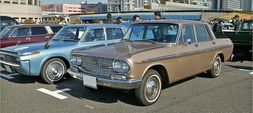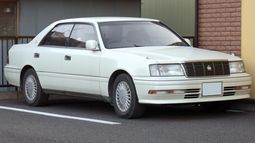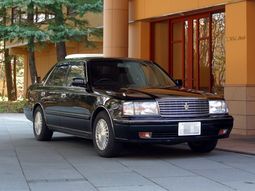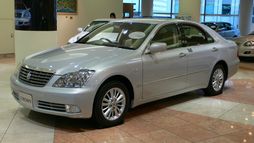The History Of Toyota Crown

The Crown has evolved into a line of full-size luxury sedans by Toyota. The range was primarily available in Japan and some other Asian countries, originally designed to serve as a taxi. It was in later years sold in the United States during the late 1950s and up until 1971. The Crown is Toyota's oldest sedan still in production. It is outranked only by the Century and the Majesta in social status. The Crown is used by many Japanese companies as the company limosiune. Exports to Europe began in 1964 with the first cars going to Finland. Other European countries which saw imports of the Crown included the Netherlands and Belgium. The United Kingdom was another market until the early 1980s. It was also exported to Canada for a few years—1965–68. In many markets the Crown had become very expensive and was replaced by the Cressida when that model became available for export in the early 1980s.
Australia was another important export market for the Crown—to the extent that it was manufactured there from the mid-1960s until the late 1980s using many local components.
Most models of the car are distinguishable by a front "Crown" badge, but the common Toyota badge is usually used on the rear.
The Crown has existed in some form since after the war and Toyota uses the "Crown" name as inspiration for their primary sedans, the Corolla which is Latin for "small crown", the Camry a phonetic transcription of the Japanese word kanmuri that means crown, and the Corona which is also Latin for crown.
The Crown was introduced in 1955 to meet the demand of public transportation in the form of a taxi, with the same 1.5 L Type R engine used on their previous car, the Toyopet Super. Its coil and double wishbone independent front suspension was a departure from the leaf sprung live axle front suspension used on most previous models but was similar to the independent front suspension used on the 1947 Toyopet SA. The live axle rear suspension was similar to that used on most of the previous models (unlike the trailing arm rear suspension used on the SA). Taxi versions were produced and commercial versions of the vehicle were also available as an estate wagon and a 3 or 6 seater coupe utility.
The Crown was designed to replace the Super but Toyota was not sure if its independent front coil suspension and its suicide type rear doors were too radical for the taxi market to bear. So the Super was updated, renamed the Master and sold alongside the Crown. When sales of the Crown proved worthwhile, the Master was discontinued in November 1956 and production facilities for the Master were transferred to the Crown.
The initial RS model received a cosmetic update in 1958 to become the RS20. In 1961 the 1.5L R engine was replaced with the similar 1.9L (1896cc) 3R engine to become the RS30.
The commercial models (utilities, wagons and vans) were known as the Master Line. The body panels were altered slightly in style as well as function but were otherwise the same as the rest of the Crown range.
Exports of the first Japanese car to the United States began in 1957 and ended in 1960. The reception of the car were horrible. As a publicity stunt to demonstrate the car's reliability, Toyota did what many American automakers had done earlier; they staged a coast-to-coast endurance run from Los Angeles to New York. As things turned out, the Toyopet was barely able to limp into Las Vegas before the project had to be called off. Since the car was designed for the muddy, slow, unpaved Japanese roads, it failed the mass urban landscape of the US because of its inability to keep up with traffic on the faster intestate highways . Unknown to Toyota, they just designed a very high quality sedan on a truck like chassis. The overbuilt heavy body was no match for the original 1.5L 4-cylinder. To try and remedy this, a newer more powerful engine was expected to be the solution, but the improvement were only minor. In 1960 the Crown stopped being imported to the US market. Many unhappy dealers were left with large amounts of stock. The Tiara and Land Cruiser would be the only cars imported until the second generation Crown was available five years later. This is the car that gave Americans a bad image of Japanese built vehicles. It was solid, but being underpowered, uncomfortable and lacking some basic amenities while costing more than similar offerings from Europe sealed its fate.
In November 2000, Toyota released the Origin, a retro version of the RS series Crown to celebrate 100 million vehicles having been built in Japan.
Due to the introduction of the Corona, the dramatically restyled and enlarged Series S40 was launched in 1962, and saw the introduction of the Custom model. According to the Japanese Wikipedia article for the Crown, the styling was said to be influenced by the recently introduced Ford Falcon in 1960. The station wagon body style first appeared with this model. Headlights were integrated within the boundaries of the greatly enlarged grille, providing a clean, modern appearance. A 2-speed automatic transmission was introduced, called Toyoglide, with a column shift. A bigger and better car than the previous S30 series, it initially had four-cylinder R-series engines before the addition of the "M" six-cylinder engine in 1965. Deluxe and Super Deluxe models were available with added features. The sedan and wagon were known simply as the Crown while the commercial vehicles (pick-up, double cab pick-up and van) were known as the Masterline. There was also a limited run of the sedan known as the Toyota Crown S (MS41S) which featured a twin carburator intake manifold on the 2.0L M in-line-six engine and disc brakes on the front.
Crown Eight
The longer, wider and more upmarket Crown Eight was introduced in 1964 for the Japanese market, powered by a 2.6L V8 engine. However, it had a different model designation, VG10. The Crown Eight was designed primarily to replace full-sized American automobiles that were commonly used by major corporations. The Crown Eight represents the first Japanese mass produced vehicle with an 8 cylinder engine. The main rivals at the time were the Prince Gloria Super and Nissan Cedric both of them sporting a 6 cylinder engine. The Crown Eight was replaced in 1967 by the first Century with the model code VG20. Approx 3,800 Crown Eights were produced.
Launched in 1967, the mechanicals were much the same as the previous generation, but additional equipment was included. Higher specification models used the 2.0 litre M engine or the 2.3 litre 2M engine while lower models were equipped with the R-series 4 cylinder engines. The range included the 4-door station wagon, pick-up (rare), double cab pick-up (very rare) and the new 2-door hardtop. In 1969 the Crown received a face lift for the headlight, grill and trim arrangement.
Notable features on the wagon were:
- 7 or 8 passenger seating (2 on front buckets or 3 on a bench seat, 3 on a rear bench seat and 2 on a fold up cargo seat),
- a powered rear window,
- a side swing tailgate.
Launched in 1971, the 4M 2600 engine was introduced with this generation, as was the luxurious Super Saloon trim level, followed by the Super Deluxe and Deluxe. The 2.0 liter M engine was also available in certain markets.
The Sedan and Wagon are coded MS60/ MS65 and MS62/ MS63. The Hardtop Coupe is MS70 (2.0 liter), or MS75 (2.6 liter). This generation was the first Crown marketed as a Toyota in Japan, as previous models were marketed as Toyopets. Also, in Japan, this model was known as the "whale" or "kujira" Crown. Domestic market Hardtop has rectangular headlights, all export models come with twin round headlights. This model sold very badly in the US, possibly related to the futuristic styling with flush bumpers that was a bit ahead of its time. Only the first 2 years were exported. This is the last Crown sold in the USA. The Corona Mark II, replaced the Crown in the US market.
The trunk could be opened remotely by turning the ignition key to the far left, and a button on the floor caused the radio to engage the signal seeking feature. A separate signal seeking feature was installed for rear seat passengers, installed behind the front seat facing the rear seat compartment.
Launched in 1974 in Japan, export began from 1975. Offered as 4-door Sedan, 2 door Hardtop Coupe, 4-door Hardtop Sedan, Wagon, and Van. Engines are 2.0 and 2.6 liter gasoline. The 2.2 liter diesel was introduced September 1978. Trim levels are Standard, Deluxe, Super Saloon, and the top of the line Royal Saloon was first introduced. Minor change was given in 1978. This version of the Crown saw the introduction of disc brakes at both the front and rear axles, speed sensitive power steering, and a 4 speed automatic transmission with overdrive.
Initially available with the "old style" 4M engine with rounded valve cover, later models switched to the new 4M engine with rectangular valve cover. This generation also saw the introduction of fuel injection on both the 2.6 liter 4M and the 2.0 liter M engines. Select models also were available with 4 wheel disc brakes and twin piston calipers on the front brakes.
The pillarless Hardtop Sedan model has a front chrome grill and square headlights.
Launched in 1979, this model had the engine upgraded from the 2.6L to 2.8L 5M-EU model. The 2 litre M was still on offer along with a turbo charged version—the M-TEU. The carburated 5M enginewas also available in certain markets. In this series the model designation referred to the engine size—MS110 (2 litre), MS111 (2.6 litre), MS112 (2.8 litre). Early models have twin rectangular headlights, facelift models come with bigger monoblock headlights. Domestic market Royal Saloons use the large rectangular headlights. Lower grades Van and Taxi adopt round headlights. Royal Saloon features longer bumpers. The first Crown Turbo was launched in October 1980 for Japanese market only. This generation is the last for 2 door Hardtop Coupe, which was replaced by the Soarer. Some of the options that became available were a glass moonroof, power drivers seat, cruise control, electronic stereo tuner, and two-tone paint. Automatic climate control also appeared on this vehicle with separate controls installed for rear seat passengers as well as a rear mounted mini fridge cooled by the rear seat airconditioning. The 2.4 L turbodiesel appeared August 1982.
Launched in 1983, this model used all three versions of the 5M 2.8 liter engine, the 5M carburated version, 5M-E single overhead cam (SOHC) fuelinjected version and the 5M-GE double overhead cam (DOHC), 1G-GE 2000 cc DOHC, M-TE 2000 cc single overhead cam (SOHC) Turbo, M-E 2000 cc SOHC, 2L-TE 2400 cc SOHC Turbo Diesel or 2L 2400 cc SOHC Diesel engines. Base versions use the new 2 litre 1G-E engine which replaced the old 2 litre version of the M series. The "van" version of the station wagon (the GS126V as well as the GS136V in the following series) used its own unique variant of this motor (the 1G-EJ). The lower grade models were available with Toyota's F292 live axle rear suspension while the rest introduced 4 wheel independent suspension on the Crown for the first time. The S120 was available in Hardtop sedan (frameless door glass), sedan and wagon versions. The Super Saloon and Royal Saloon versions were packed with nifty features such as dual zone climate control, front and rear stereo and A/ C control buttons, parcel shelf mounted refrigerator, automatic headlights, reading lamps for all outboard seating positions, tilt & telescoping steering column, glovebox mounted courtesy mirror among many things. One distinctive styling feature of this generation was the use of a clear panel with patterned backing for the C-pillar trim on the sedans. Toyota made the 190hp Twincam 12-valve 3.0 liter 6M-GE available on the Royal Saloon for the mid cycle update. This engine is a popular swap for 5M-GE powered Celica Supras of the same period.
Launched in 1987. Body style: Sedan, Hardtop, and Wagon, included the commercial Van. The model used 7M-GE 3000 cc DOHC, 1G-GZE 2000 cc DOHC Super Charger, 1G-E 2000 cc DOHC, 2L-THE 2400 cc SOHC Turbo Diesel Hi Power (AT Use), 2L-TE 2400 cc SOHC Turbo Diesel (MT Use) or 2L 2400 cc SOHC Diesel engines. The 4.0 liter 1UZ-FE, the same engine as in Lexus LS400, was only for Royal Saloon G. Although a totally different chassis and body, the S130 shares styling cues with the MX83 Cressida.
The Crown Hardtop and all-new Crown Majesta models were built on the 140-series platform. The rebodied Crown Sedan and Wagon still carried S130 model codes, although the exterior is rounder, and the nose is similar to S140 Hardtop.
Trim levels for Sedan are Standard, Deluxe, Super Deluxe, Super Saloon, Royal Saloon, and Royal Saloon G. Engine choices were 2.0, 2.5, 3.0 liter gasoline, and 2.4 liter diesel. The 4.0 liter was offered for Royal Saloon G and Majesta.
The Crown Majesta is a car related to the Crown but is bigger, more luxurious and has a V8 engine shared with the Lexus LS and has many expensive electronic optiona. The Crown Majesta has been produced since 1991.
The Standard Sedan for Taxi and base model Wagon feature round headlights and chrome bumpers. The taxi is powered by 2.4 liter diesel engine matched to 4 speed column-mounted manual transmission.
The 150-series Crown were built as Sedan and Hardtop (frameless door window) only. This was the first Crown to not use separate chassis construction. The Wagon retained the old and uninspired Japanese Lexus (130 series) model until 1999. Trim levels for Hardtop are Royal Extra, Royal Saloon, Royal Saloon G, and the sporty Royal Touring. 4WD is offered for Royal Extra and Royal Saloon. Engine is either 2.0, 2.5, or 3.0 liter 6-cylinder.
Main article: Toyota ComfortIn an effort to return to the original purpose of the Crown, which was to serve as a taxi, The Crown Comfort had smaller exterior dimensions but a roomier and taller interior than the Crown Royal series. To reduce unnecessary cost and weight and increase interior space, the more luxurious dashboard and fitments (including leather seats) of the Crown Royal were replaced with less bulky all-plastic versions.
The Comfort is powered by either the 3C diesel engine or LPG. The Japanese model has fender mirrors and an automatic (driver-activated) rear door. The Crown Comfort is the most popular taxicab in Japan, Hong Kong, and Singapore, but is gradually falling out of favour as better-appointed vehicles become available at competitive cost.
The new Crown Sedan for the Japanese market only is based on the Comfort, but has wider tail lights and longer bumpers.
The 170-series features shorter front overhang therefore maximizes interior and trunk space. There are two different 170-series 4-door Saloon; the Royal, and Athlete. The Majesta is a separate vehicle which is larger and longer than the Crown. The 4-door Hardtop was discontinued. The 170-series Estate was the first new Crown Wagon after the 130-series. Engine is either 2.0, 2.5, or 3.0. The Athlete V has 2.5 liter 1JZ-GTE turbo. The Royal was also offered with 3.0 liter 2JZ-FSE Mild Hybrid.
The S180 model of the Crown was based on the Zero Crown concept car. The engine was changed to a V6 for the new Royal and Athlete models, while the Crown Majesta used the V8 only, now in 4.3 litre form with 4WD optional. The new engines gave more performance while also giving better fuel economy.
Compared with the previous model, this model was increased by 70mm (2.8in) in the wheelbase and 15mm (0.6in) in body width. These changes gave it the largest interior size among its contemporaries, more than the Mercedes-Benz E-Class or BMW 5-series.
The S170 series Crown Estate was continued alongside the S180 sedans. It continued using the older inline 6-cylinder engines.
The new Crown is available in 5 different trim levels: the basic Crown Sedan; the Crown Royal series which is a more comfortable and luxurious car; the Crown Athlete series which takes the luxurious aspect of the Royal series but has more aggressive styling and sporty features; the Crown Majesta series which is larger and has more luxurious features than the Royal series; and the Crown Hybrid series which is a trim level designated for the hybrid V6 drivetrain. The Crown is one of the first vehicles to have a 3 Dimensional Satellite Navigation System and boasts many features that have not been developed by other luxury car makers. The Crown is set to rival the European BMW 5 series, Mercedes E-class, Audi A6 and the Japanese Honda Legend & Nissan Fuga. This is the Longest and widest Crown to be built.
The Crown hybrid concept was exhibited at 2007 Tokyo Motor Show.
- Crown Sedan
- Crown Hybrid
- Crown Majesta
- Crown Royal Saloon
- Crown Athlete
The Crown Comfort and Crown Estate models were dropped for the 2008 model year.
From Wikipedia, the free encyclopedia
More About Toyota Crown





































|